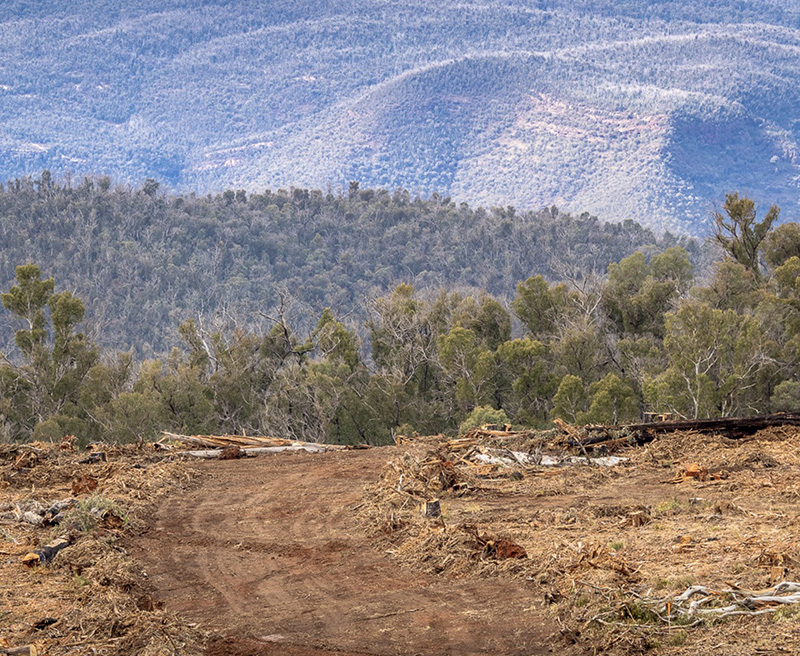It’s just another day on the job to save the world from man-made pollution
In a quest to make the weather a bit nicer in 100 years these trees needed to be cut down now so we can connect up a big hydropower “battery” for holy solar and wind power. The towers will be 75m high and the path through the forest, 140m wide.
When we ran off coal and gas power, we didn’t need pumped hydro. Fossil fuels protect the forests and hills of Australia.
These photos were posted by Geoff Wise on the “High Country of Australia” show us what our clean green future will look like:
Here is where the power lines from the Snowy Hydro 2, at Lobs Hole, will cross the Tumut River ravine to go to the recently cleared site of the switching station in the Maragle State Forest, before heading north to feed into the National Power grid. The power lines will come from near the distant horizon. Look at the photos for more information. You can see this for yourself, as I was standing on Elliot Way when I took the photos, down hill, to the east is Kosciusko National Park and uphill, to the west is Maragle State Forest.
Other parts of this project (not pictured here) will even cut through national park. Originally the 330kV interconnector towers were going to be put underground in the Kosciusko National Park, but after costs ballooned it was decided that the Snowy Hydro 2.0 pumped storage was “critical state significant infrastructure to NSW for economic, environmental and social reasons” and the National Park was not so significant. Who knew, socially, people in NSW benefit from pumped hydro?
Apparently renewable shareholders have friends in high places. Trees and koalas, not so much.
h/t Roger
Remember small business foresters and farmers are bad people, but industrial hydroelectricity helps the environment. See how caring they are with their clearing…
Geoff describes how extensive these lines are: “One of the power lines from there travels through Maragle State Forest, then Bago State Forest. A second travels through from Cabramurra and next to the new switching station being built. Snowy Hydro 2 may add, 1 to 2, more lines, as two lines are going to the switching station.“
The standard joke on facebook with these photos is “look at the damage those brumbies have done”:

Clearing in the Snowy Mountains for high voltage lines (from Elliot Way) between Maragle and Lobs Hole.
Because over the hill, feral brumbies are being shot from helicopters to “reduce their impact” on the Alpine wilderness.
Though some wonder if it’s more the high country colonial history that the bureaucrats are really trying to kill.
Geoff also notes the irony that electric vehicles will be everywhere in the renewable future, but they won’t be allowed in the Snowy hydro power station. He wonders, after all the combustion engines are gone whether they’ll need those horses to pull the carts:
I received an email from a well informed commentator who noted that the Lobs Hole approval notice is allowed to kill and displace all sorts of things:
The Critical State Infrastructure Approval for the Lobs Hole and the Switching Station on KNP allows that no more than:
(i) 9.35 ha of Caladenia montana species habitat
(ii) 89.06 ha of Gang-gang Cockatoo (breeding) species habitat
(iii) 10.86 ha of Masked Owl (breeding) species habitat
(iv) 117.29 ha of Eastern Pygmy-possum species habitat
(v) 59.03 ha of Yellow-bellied Glider species habitat; and
(vi) 1.67 ha of Booroolong Frog species habitat
can be cleared for the development; and the developers have to minimise:
(i) the impacts of the development on hollow-bearing trees;
(ii) the impacts of the development on threatened species; and
(iii) the clearing of native vegetation and key habitat.
Apparently, the sanctioned clearing is offset by contributing or buying offset credits.
The question is, why can’t farmers within the Great Barrier Reef catchment area have the same option when managing their land? At the moment, bureaucrats scan satellite images and if any bare ground the size of a kitchen table is found on their land, they turn up and carry out an audit essentially accusing the farmer of environmental degradation of the Great Barrier Reef.
— R
Some endangered industries are more protected than others.
10 out of 10 based on 1 rating
via JoNova
June 19, 2024 at 04:47PM
